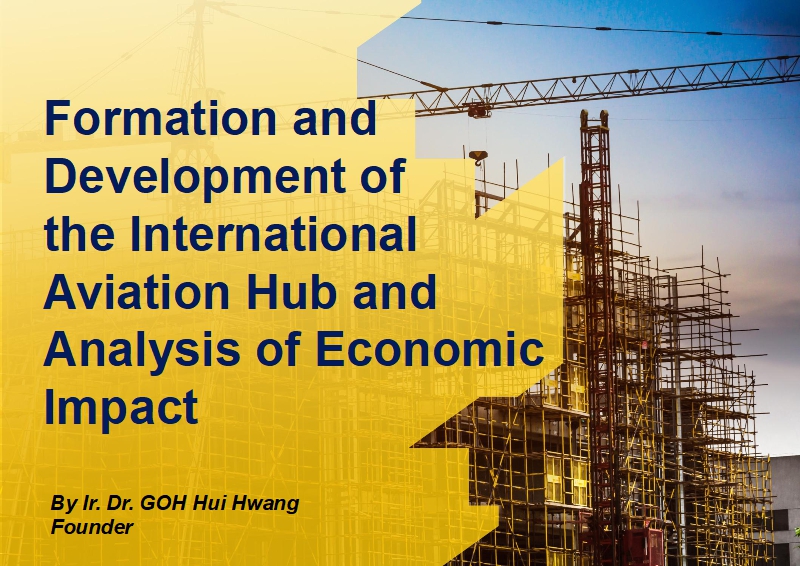Author: Ir. Dr. GOH Hui Hwang | 23 February, 2020
Since the founding of the People’s Republic of China 70 years ago, the rapid economic development has driven the reconstruction, expansion, and new construction of airports, and even people often feel that in the context of China’s rapid economic development, building an airport has never caught up with the exponential growth of demand.
On the other hand, airports have also become the key to driving economic growth. From Guangzhou Baiyun Airport, which was at the forefront of reform and opening up, became the busiest airport in China. In recent years, inland cities such as Chongqing and Chengdu have seen the construction of “air corridors”. With the opportunity to open up new channels to the outside world, the role of airports in the economic development of one country and one place has become increasingly prominent in the context of globalization. International Civil Aviation Organisation (ICAO) has estimated that for every 1 million air passengers, it can create economic benefits of USD 130 million for the surrounding area, which can bring 1,000 direct jobs. For every 100,000 tons of air cargo, 800 jobs will be created directly.
From this perspective, the airport is both a “barometer” of economic development and an “engine” to promote economic development. For some domestic new airports, the word “engine” does not seem to be enough to summarize its impact on the country, Great role played by regional development.
The planned annual passenger throughput of Beijing Daxing Airport can reach 100 million passengers, but just last year in 2018, the Beijing Capital airport’s annual passenger throughput exceeded 100 million passengers.
In Beijing, the speed of airport expansion and new construction seems to never keep up with the speed of rising demand. This is the epitome of the embarrassment faced by many cities in China. Some people have described it as air transportation is like a child who grows very fast. Building a new airport is like making clothes for children, and they are small without much wear.
The recently opened Daxing International Airport has also become an important part of the free trade zone. It is reported that the commissioning ceremony of the Beijing Daxing International Airport was held in Beijing on September 25, 2019, which also marked the official operation of Daxing Airport routes. By then, the Daxing Airport area will take full advantage of the new airport value.
In fact, many airports in the world are not only airports, but also well-known free trade zones, such as the Dubai Airport Free Trade Zone (DAFZA). The establishment of the Daxing Airport area will help promote the development of the world-class urban agglomeration of Beijing, Tianjin, and Hebei, and will also explore a demonstration path for the coordinated development of other regions.
This kind of bidirectional connection between airport construction and economic development is not uncommon worldwide. For example, in 2013, European airports directly, indirectly or catalyzed the employment and income of 1.23 million people, creating a GDP of 675 billion Euros, which is 4.1% of EU GDP.
Zurich Airport is the largest airport in Zurich, Switzerland, and the main base of Swissair. It has attracted 280 companies to settle in, bringing direct economic benefits of up to 4 billion Swiss francs per year. If direct and indirect income is included, then Zurich Airport will contribute more than 13 billion Swiss francs to Switzerland’s GDP. The airport directly employs more than 25,500 people, which is approximately equal to the entire Swiss Railways. If the indirect relationship is counted, Zurich Airport can create 75,000 employment opportunities. Although only 3.7% of Swiss exports depart from Zurich Airport, these goods are worth 35% of all Swiss exports.
Another example is the Wisconsin State of the United States published in 2005 the General Mitchell International Airport’s economic impact analysis report. Its approach is very different from the Virginia Civil Aviation Department. It is also mainly divided into 4 factors:
1. Revenue impact: Commercial revenue brought by the airport by providing passenger services, freight services, ground support services, etc. This revenue can be used to hire employees, purchase products and services, and invest abroad,
2. Employment impact: direct employment (direct employment generated by airport activities); indirect employment (depending on airport-active enterprises); induced employment (due to the existence of the airport, direct-employed employees spend on purchasing products and services locally, thereby Locally created jobs); related employment (locally related economic jobs. For example, companies use airports to handle cargo operations, etc.,
3. Impact of personal income: income received by individuals through airport activities and local expenditures,
4. Tax impact: The situation in which enterprises and individuals pay taxes to the federal and local governments.
It can be said that various methods adopted by various airports in calculating their own economic influence are also various. Generally, according to their own specific conditions and calculations (especially the difficulty of data collection) models, the final choice of economic influence is finally determined.
In the future, the Daxing Airport area will use its advantageous geographical location, integrated aviation transportation hub, and 100 million passengers per year to become an international airport city and a world-class urban hub center comparable to the international free trade zone. Relying on large international aviation hubs to build functional bearing areas of international exchange centers.
Ir. Dr. GOH Hui Hwang
Founder
IPM Group

